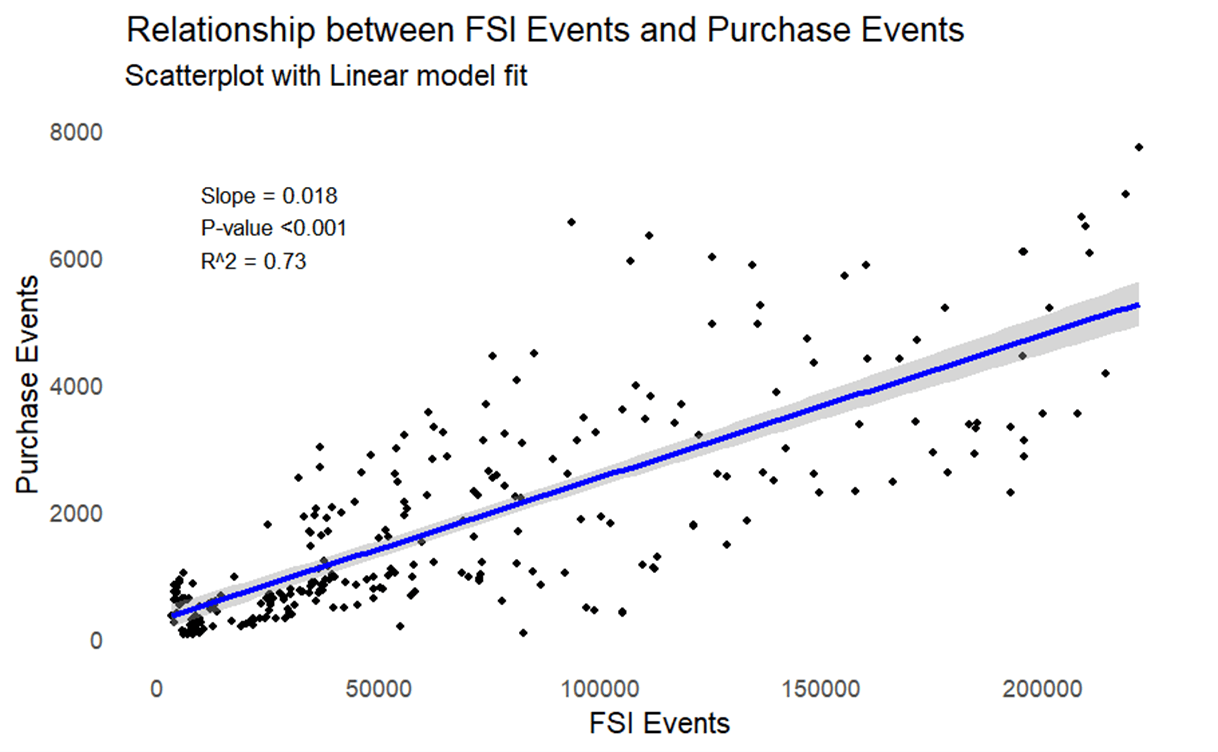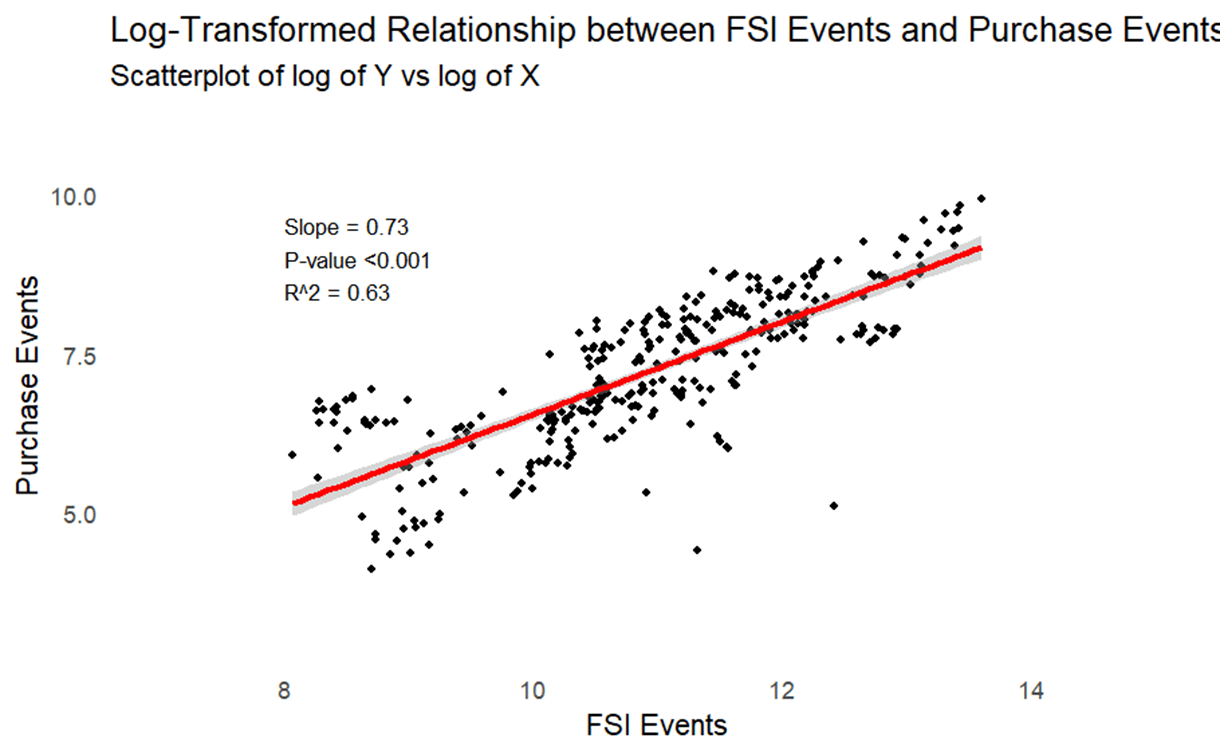Why FSI Should Be the North Star Metric in the Absence of E-Commerce Data
Introduction
In eCommerce, understanding purchase behavior is crucial for optimizing marketing strategies and driving revenue. By analyzing what motivates customers to buy, businesses can refine their offerings, tailor their messages and improve the overall shopping experience. However, in some cases, a desired outcome (a primary metric like airline transactions) may be difficult to measure promptly.
This research aims to answer a specific and practical question faced by many airline marketers: Can Flight Search Initiation (FSI) be used as a reliable proxy for flight purchases when eCommerce data is unavailable or difficult to access?
While airlines often rely on direct transactional data to evaluate digital marketing performance, this information is not always accessible due to technical constraints, tracking issues or analytics limitations.

This study is not a general exploration of all available airline performance metrics, nor is it designed to replace eCommerce data when it is robust and available. Rather, it focuses on finding early signals of potential transactions originating from airTRFX pages, when conversion-level data is not available.
Thus, we defined and started to measure several metrics, including Flight Search Initiation (FSI). FSI is a type of “click-to-search” metric that captures the number of times users go from airTRFX pages to the airline’s Internet Booking Engine (IBE), that could potentially serve as an early indicator of booking behavior.
The study, outlined below, demonstrates that FSI can serve as a reliable proxy for flight purchases. A proxy metric is a substitute indicator that takes the place of a higher-level metric when direct measurement is unavailable or impractical.
This means that FSI can be used as a measurable indicator of the value of airTRFX pages. Additionally, airline marketing teams can target FSI as the most important Key Performance Indicator (KPI) when evaluating marketing campaigns or A/B tests in the absence of eCommerce data.
What Is FSI?
FSI is measured as the number of visits from airTRFX pages to the airline’s internet booking engine (IBE). It captures user clicks—signaling intent to search for or book a flight — and serves as a valuable early-stage indicator of purchase behavior. Importantly, FSI does not capture or contain any personal data. It is an aggregate, numerical metric not tied to individual users, sessions, or personally identifiable information (PII).
The Research Question & Methodology
Can FSI serve as a reliable proxy for completed purchases?
To answer this, we analyzed monthly data from 27 airline clients powered by PROS airTRFX in 2024. We evaluated the relationship between FSI and purchase events using two types of analysis:
- Pearson Correlation Coefficient — Quantifies the strength and direction of the linear relationship between two variables. A value close to 1 indicates a strong positive correlation, meaning that as FSI increases, purchases also tend to increase.
- Linear Regression Models — Model the relationship between FSI and purchases to test both predictiveness and proportionality:
- Simple Linear Regression — Measures the direct linear association between FSI and purchases without adjusting for differences across clients.
- Log-Log Regression — Applies a logarithmic transformation to both FSI and purchases to test for the proportional (percentage-based) relationships between the two metrics, focusing on relative rather than absolute changes.
The Results
Across all models, we found a consistent, strong, and statistically significant relationship between FSI and purchase events. All relationships reported are statistically significant (p < 0.01), ensuring the reliability of the observed association.
1. Pearson Correlation Coefficient
- Coefficient: 0.77
- Interpretation: A strong positive linear relationship between FSI and purchases, meaning as FSI increases, purchase events tend to increase as well
2. Simple Linear Model
- Slope: 0.018
- R²: 0.736
- Interpretation: On average, for every additional FSI event, purchase events increase by 0.018.
3. Log-Log Linear Model
- Slope: 0.73
- R²: 0.64
- Interpretation: There’s a clear proportional relationship between FSI and purchases. A 10% increase in FSI leads to a ~7.3% increase in purchases on average.
Visualizing the Findings:
Linear Regression Plot: FSI Events vs. Purchase Events

Log-Log Regression Plot: log(FSI) vs. log(Purchases)

Why It Matters for Airline Marketers
Flight Search Initiation offers a valuable early transaction signal — especially important when purchase data is unavailable.
For airline marketing teams, this is helpful because FSI can:
- Fill data gaps: Helping track performance even when eCommerce data is unavailable.
- Support experimentation: It can be used even if eCommerce data is available, but when it’s difficult to use transactions as the A/B test target metric
- Act as a Secondary KPI: By providing a stable and actionable metric to monitor performance alongside other primary KPI’s such as purchases.
By treating FSI as a proxy for transactions, airline teams can stay proactive, data-driven, and responsive — even in the face of imperfect or missing data.
Final Takeaway
Flight Search Initiation is a reliable, statistically validated proxy for flight purchase events. It tracks early transaction intent with strong predictive power, making it an ideal metric for marketing teams that need to optimize campaigns and conduct A/B tests when purchase data is unavailable or lagging.
As a next step, further research could explore the movability of FSI — that is, how effective marketing actions can influence FSI and, in turn, drive purchases. Confirming moveability, which refers to metrics that can be influenced (moved) through interventions or strategies — and thus, could serve as actionable levers toward improving a primary goal or KPI. This would strengthen FSI’s role not just as a passive indicator, but as an actionable lever for growth.
Whether optimizing digital campaigns, testing landing page performance, or benchmarking across airlines, FSI offers a powerful early signal of transactions that marketers can use to make decisions.
Frequently Asked Questions
FSI measures the number of visits from airTRFX pages to an airline’s booking engine, signaling early intent to search or book a flight.
Yes, FSI has a strong correlation with purchase events, making it a reliable proxy when direct eCommerce data is unavailable.
FSI provides an early indicator of transaction intent, enabling marketers to track performance, optimize campaigns, and conduct A/B tests.
FSI and purchases have a Pearson correlation coefficient of 0.77, indicating a strong positive relationship.
A 10% increase in FSI typically results in a ~7.3% increase in purchases, based on log-log regression analysis.
FSI fills data gaps, offering a measurable and actionable metric to evaluate marketing performance and customer intent.
Yes, further research suggests FSI is a moveable metric, meaning it can be influenced by targeted marketing strategies to drive bookings.

